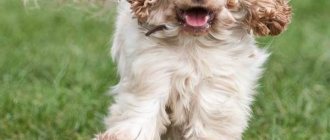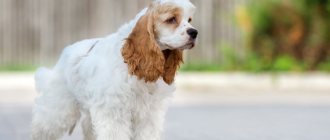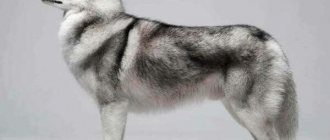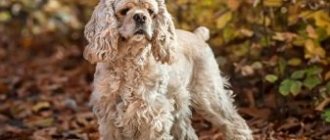The history of spaniels begins in the 14th century. In 1801, the breed was divided into two varieties: springers (hounds) and cockers, used for hunting woodcocks (birds leading a crepuscular lifestyle). As a result, in the 19th century, cocker spaniels were considered a whole dozen similar breeds, called field hunting dogs. The confusion ended in the early 20th century when the Kennel Club of Great Britain identified the English Cocker Spaniel as a separate breed. Today it is considered more decorative than hunting.
American and English Cocker Spaniels are small dogs that grow at the same rate. Owners should monitor their puppies' weight gain to monitor their development.
Brief history of the breed
The history of the spaniel breed begins in the 14th century. The breed is believed to have originated in Spain. In the 15th century, spaniels were considered a type of hunting hound.
The first division of spaniels into species was documented in 1801. The breed was divided into two types:
- Springer is a hound dog.
- The Cocker is a dog that was used to hunt woodcock (a secretive, nocturnal bird).
By the 19th century, all dogs of the Cocker Spaniel type were considered field hunting dogs. Note that the group of “field” dogs included about a dozen breeds that were similar to each other, but were used for hunting different game.
Until the 1870s, all dogs in the breed type weighing less than 11 kg were considered cocker spaniels. In the 70s, cocker spaniels were divided into subspecies. It was then that the King Charles Spaniel breed was “founded”. Confusion among dogs weighing 11 kg or more reigned until the 1900s. It was only after the founding of the Kennel Club of Great Britain that Cocker Spaniels were identified as a breed.
This is interesting! After the founding of the Kennel Club of Great Britain, the breeding of Cocker and Springer Spaniels was divided, which was the reason for the consolidation of the gene pool.
However, the history of the Springer and Cocker Spaniels is tightly intertwined. It is believed that the ancestors of the English and American varieties of cocker spaniels were the father and son of the springer spaniel breed. The father, named Obo, was medium-haired and reddish in color.
What you should absolutely not give to dogs
All dog owners know how much their pets can beg for treats, but there are foods that should not be given to spaniels, even if you really want to:
- sugar and products containing it (yogurt with additives, chocolate and other harmful carbohydrates);
- popcorn, beer, spirits;
- avocado. It contains the toxin persin, which is contraindicated for most animals. In some countries this product is banned for dogs;
- grape. It can cause kidney failure;
- bread and dough tend to expand in the stomach and lead to irritation of the digestive tract.
Height and weight of Cocker Spaniel puppies by month
The height and weight of Cocker Spaniel puppies by month almost does not depend on the variety. American and English Spaniels grow and develop at the same rate.
The growth of a puppy at the withers by month is not regulated. Development may depend on:
- Heredity, including genetic diseases
- Living conditions - climate, ecology, type of housing.
- The duration of the suckling period and the nutritional value of mother's milk.
- Balance and timeliness of complementary feeding.
- Correct calculation of serving size and prepared diet.
- Frequency and balance of feeding.
- Factors for the presence of hereditary diseases.
The rate of development is monitored by weight, provided that the puppy is not obese.
Weight of an English and American Cocker Spaniel puppy by month:
| Age | Weight |
| From 0 to 10 days | 180–290 gr. |
| 1 month | 0.9–1.5 kg. |
| 2 months | 2.9–3.5 kg. |
| 3 months | 4.9–6 kg. |
| 4 months | 6.3–8.1 kg. |
| 5 months | 8–10 kg. |
| 6 months | 9–11.5 kg. |
| From 7 months | 10–12 kg. |
What to start feeding
During the first time of independent life, the puppy must gradually get used to eating solid food and relearn. The best diet option is considered to be one in which the spaniel eats small portions 6 times a day. Make sure that your baby does not overeat: you need to have enough energy and mobility to avoid obesity in childhood.
What is recommended to be included in the diet at an early age when choosing the option of feeding naturally prepared food:
- chicken, beef, turkey, the main thing is to avoid fatty meat;
- fermented milk products: low-fat cottage cheese, kefir, fermented baked milk;
- fish protein: cod, hake;
- stewed, boiled vegetables, diced: carrots, cabbage, zucchini.
This diet should be followed further; the owner can only increase portions and reduce the number of feedings. Ideally, an adult dog eats morning and evening, 2 times a day.
Height and weight of an adult male Cocker Spaniel
According to the standard, the height and weight of an adult male English Cocker Spaniel should be:
- Height at withers: 39–41 cm.
- Weight: 12.5–14.5 kg.
The height and weight of an adult male American Cocker Spaniel should be:
- Height at withers: 36.8–39.4 cm.
- Weight: 8–15 kg.
Males look more courageous and stronger than females. Adult males have a more proud stance and hold their heads high. The head of males is larger, the forehead is wider, the cheekbones are stronger. It is important to remember that if grown incorrectly. Representatives of the breed often suffer from hormonal diseases and excess weight. Obese dogs can weigh up to 17–20 kg.
Factors influencing growth
Height and weight gain of cocker spaniels depend on a number of factors:
- Heredity. This means not only a genetic predisposition to specific diseases, congenital pathologies, but also the parameters of ancestors. Large parents are more likely to produce large offspring than miniature representatives of the breed.
- Conditions for keeping a mother dog during pregnancy and her offspring. A pregnant dog or puppies need a calm, cozy, quiet and warm place without drafts, high humidity, or noise. Stress from unfavorable living conditions can affect the development of animals. Factors such as time of year, climate, and environmental conditions also have their influence.
- Balance, calorie content of the mother’s diet, timely introduction of complementary foods for the offspring. A pregnant dog should receive increased portions of high-calorie food on a strict schedule - it is best to stick to the menu compiled by the veterinarian. Do not forget to introduce complementary foods to puppies on time - first liquid, and then solid. Monitor their reaction to new food.
- Portion size, harmony of diet components, frequency of meals. Consult your veterinarian about your little spaniel's diet.
- Physical exercise. A growing organism must constantly move, run, play and frolic in order to develop harmoniously. However, exhausting activities and activity after a full lunch, on the contrary, harm the cubs.
How to measure a Cocker Spaniel correctly
Measurements need to be taken for several reasons:
- To track development - you need to determine height at the withers and weight.
- To choose clothes - you need to measure the circumference of the neck, the length of the back and the circumference of the chest under the elbows.
- To choose shoes - you need to measure the length and width of the paw, the height of the metacarpus and the volume of the wrist.
For weighing, it is better to use electronic scales with sufficient carrying capacity. All veterinary clinics should have such scales. Puppies can be weighed on a kitchen scale.
Height is measured as follows:
- We place the dog in a stand near a wall, cabinet, or other surface.
- Make a mark with a pencil at the level of the withers.
- We measure the distance from the floor to the mark.
Note! The back length is the distance from the base of the tail to the base of the neck.
Measurements for clothing and shoes are taken with a measuring tape. Measurements should be taken at the widest point of the girth.
Basic rules of care
Despite the fact that newborn puppies are completely helpless, their eyes and ear canals are closed and they lack their own thermoregulation, caring for them requires minimal effort on the part of the breeder, since the main concerns fall on the bitch.
If the litter is separated from the bitch, the temperature in their bed must be maintained at least +30 °C, otherwise the puppies may freeze and die.
How to bathe properly
Spaniels cannot be bathed until the quarantine period ends after the last vaccination. The exception is cases when the puppy is very dirty, but it is better to try to minimize the likelihood of this.
During the first bath, you should lay a rubber mat on the bottom of the bath so that your pet’s paws do not slip, and cover your ears with cotton swabs, eliminating the possibility of water getting into them..
The coat of representatives of this breed should be brushed 3-4 times a week, or better yet, daily. This will help get rid of dead hair and avoid the formation of tangles.
Claws
For the first time, puppies' nails need to be trimmed around the 8th day after birth to prevent them from scratching their mother's nipples, then repeat the procedure weekly, cutting off sharp edges.
Adult dogs' nails should be trimmed once every 3-4 weeks..
Eyes
These dogs are prone to eye inflammation. To avoid this, you need to wipe the puppies’ eyes daily with a cotton pad soaked in chamomile infusion or boiled water.
If there is increased lacrimation, purulent discharge or photophobia, you should contact your veterinarian.
Spaniels have long, drooping ears, which helps protect the ear canals from foreign objects entering them, but at the same time causes poor ventilation and, as a result, increases the risk of developing inflammatory diseases.
Ears should be cleaned once a week using cotton swabs and a special product that helps soften and remove wax, and ventilate daily, minimizing the risk of pathologies..
Clothes and shoe sizes for Cocker Spaniels
The sizes of overalls are selected according to the length of the back, chest and neck circumference. Shoes are also selected according to measurements; American and English Cocker Spaniels fit size S:
- Paw length – 6.5 cm.
- Paw width – 5 cm.
- Metacarpus height – 11 cm.
- Wrist volume – 12.5 cm
Important! If you are not sure of the correct measurements or do not know which model will suit your pet, it is better to try on shoes. You can try on the boots at a pet store, but order them online.
Vaccination schedule
| Age | Nobivak vaccine | Eurikan vaccine |
| 7 weeks | Deworming | |
| 8-9 weeks (vaccination against plague, viral hepatitis, adenoviral infections, parvovirus enteritis, parainfluenza, leptospirosis) | DHPPiL | DHPPI2+L |
| 11 weeks | Deworming according to indications | |
| 12 weeks (vaccination against plague, viral hepatitis, adenoviral infections, parvovirus enteritis, parainfluenza, leptospirosis + rabies vaccination) | DHPPiL+R | DHPPI2+RL |
| 1 year | DHPPiL+RL | DHPPI2+RL |
| Vaccinations are then repeated annually at the same time. |
Collar sizes for Cocker Spaniel
Collar sizes you need to consider before purchasing:
- Full length.
- Length to clasp.
- Width.
When choosing a collar, it is extremely important to pay attention to the types of fasteners and materials from which the accessories are made. For American and English Cocker Spaniels, the following collar sizes are suitable:
- SM: 35–41cm.
- M: 39–45cm.
A fastened collar should not put pressure on your pet's neck or interfere with it in any other way. Two fingers should fit and rotate freely between the neck and the collar.
Advice: for the convenience of the ward, it is better to opt for a collar that is properly fastened to 1-2 holes or purchase a nylon collar that is adjustable in length.
Popular nicknames for boys and girls
| Gender of the dog | Names |
| Male | Lorrie, Maurice, Tom, Neil, Archie, Luke, Mars, Oscar, Casper, Colin, Dani, Patrick, Barney, Dani, Bruno, Leo, Kevin, Monty, Simon, Derek, Watson, Bruce, Lucky, Tiktak, Chaplin, Elwood, Latte, Mickey, Twister, Elvis, Hustler, Rocky, Wally, Pancho, Ripley, Ozzy, Hiro (generous), Ren (lotus), Akira (bright), Arata (new), Yuki (snow), Haruki (shining ), Hayato (falcon), Hikari (light), Hinata (sunflower), Akito (autumn) |
| Bitch | Dolly, Sarah, Doni, Chloe, Trixie, Floris, Laura, Mimi, Irma, Christy, Dekla, Dori, Pixie, Eileen, Jena, May, Ruby, Cheri, Nancy, Lily, Betsy, Isa, Grace, Kira, Belle, Wendy, Linda, Sabina, Alice, Penelope, Sophie, Puma, Bridget, Snowball, Margo, Bagheera, Cleo, Sima, Lipa, Lada, Toffee, Fifa, Sabrina, Shinju (pearl), Kiku (chrysanthemum), Aimi (beautiful love ), Haru (spring), Natsumi (beautiful summer), Yuri (lily), Sakura (cherry blossom), Hoshi (star), Nami (wave) |
Dimensions of a bed and a booth, a house or an aviary for a cocker spaniel
The Cocker Spaniel is an apartment dog, but for the purposes of education, safety, or temporary foster care, a cage or enclosure may be required. In addition, to organize a place for the dog to rest, you will need a lounger or a house.
Minimum sizes of a bed and a booth, a house or an aviary/cage for an American and English Cocker Spaniel:
- Rugs, beds - sizes L and M - minimum 50x50 cm excluding sides.
- Cage or enclosure - minimum 116x75x70 (width, depth, height).
The dog's enclosure should have a free space for a bed, bowls, and, if necessary, a tray.
Main rules
Caring for a pet is a serious, responsible task; the owner should treat care with particular rigor.
At the time when the puppy is weaned from its mother, teeth begin to appear, and it is time to learn to eat solid food. The best option is for the dog to begin switching to solid food at the age of two months. Then the owner is faced with a choice of what to feed the spaniel:
- naturally prepared food;
- professional dry food.
As soon as the dog has changed homes or left the kennel, it must be gradually accustomed to the new feeding system in order to avoid intestinal and stomach disorders. Both options have advantages and disadvantages:
- Naturally prepared food will help make the diet varied, but the owner will need to carefully monitor the vitamins that the pet should receive from food. Selecting products will be an important task that requires special care.
- Professional dry complexes contain the necessary vitamins and minerals that a puppy needs. Today, a lot of lines of dog food of different tastes have been developed, allowing you to diversify your food. Minus: the professional complex is expensive.
Attitude towards children and other family members
This is a lively, curious and cheerful dog who is happy when his owners are at home. He does not like to be left alone for a long time, so breeders advise keeping a pair of spaniels if you are at work for a long time.
The delicate and even overly neat cocker is smart and quick-witted, but with a trick - it’s difficult to refuse this loving, touching look a cookie, but it’s necessary.
The dog loves children very much and reacts calmly to pets. But there is a sincere hostility towards cats, which can take away part of the owner’s love. There will be a quiet but constant war with them in the house.
The disadvantage of Cocker Spaniels is some nervousness and fussiness. Therefore, always speak to your cocker in a gentle and calm manner. Violent manifestations of emotions can provoke a puddle on the parquet from an excess of feelings.
Learning ability
In terms of learning ability, the “star” character can again play a cruel joke. The Cocker must be constantly praised, but scolding is prohibited. The dog will understand the reproachful tone, but will simply demonstratively not react to the scream.
On the scale of intelligence and intelligence, a cocker deserves five points, but with reservations. We need to find an approach to this proud handsome man. He must be the best and the first in everything - the owner’s praise is the best incentive for training.
Water
Drinking, clean water must be available at all times. Thirst without drinking water, even short-term, leads to metabolic disorders.
Particular attention is paid to water when:
- feeding with prepared food;
- high physical activity.
You need to monitor your water consumption. Drinking too little or too much water is not a disease, but may be a sign of certain metabolic disorders. In this case, you should consult a doctor.











